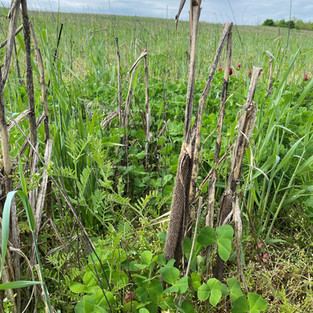National Pollinator Week June 22-28
- info376879
- Jun 16, 2020
- 2 min read
Anything instrumental in providing 1/3 of the food that reaches everyone’s plate certainly deserves a week of recognition. Pollinators do just that! Pollinators come in an array of insects and animals-birds, bees, butterflies, moths, bats, beetles, and more. Thirteen years ago, a week in June was designated as National Pollinator Week. June 22-28 is this year’s National Pollinator Week.
Habitat loss, disease, parasites, invasive species and pesticide use have triggered a decline in pollinators. This special week is designated to celebrate pollinators and to also bring awareness of their importance. It’s a time many conservationist provide landowners, land managers, and farmers with various types of outreach and resources to improve pollinator habitat on the land they impact.
Dozens of conservation practices can support pollinators.
Field borders are areas along the edge of crop fields and often take up relatively low acreage of the total field. These areas are more often than not are low yielding, especially when they are located near forest edges. Why not consider seeding a perennial mix that includes plants species that will attract and provide habitat for pollinators?
Maybe you have a whole field, big or small, that is hard to farm due to its size, location and/or shape. Consider converting it to a pollinator plot. It may potentially be more profitable!
One of my favorite practices that can support pollinators is a good Cover Crop mix. Indiana cash crops do not often provide a healthy habitat and food source for pollinators. Selecting cover crop species such as clovers (crimson clover is a favorite), sunflowers, buckwheat, vetch and many others are sure to draw in lots of happy little pollinators by providing food and habitat above the soil surface. Below the surface, the roots of these plants are serving multiple other functions. They are building soil health by stabilizing the soil from erosion, forming soil aggregates, increasing organic matter and water holding capacity. The plant diversity supports an environment for biodiversity. Nodules on the legumes busy themselves fixing nitrogen (at no additional charge to you!) for you next nitrogen loving crop. I have heard the sunflowers can scavenge zinc, one of those important micronutrients.
Don’t forget about those other non-flowering cover crops species like cereal ryegrass, oats, and annual ryegrass and the benefits they can provide to pollinators. They may not provide sweet nectar and pollen, but they do provide habitat. Pollinators, like native bees, will nest in the soil and dead vegetation provided by the grass species.
Reach out to your local Soil and Water Conservation District or United States Department of Agriculture Service Center for technical support on ways to support pollinators on your farm or land. Many offices may also be able to provide financial support from local, state, federal or private sources to implement pollinator and soil health practices.
All 92 counties in Indiana have a Soil and Water Conservation District. For a list and contact information for your local district, visit http://wordpress.iaswcd.org/contact-your-local-swcd/.
For a list of Indiana USDA Service Centers (which are often, but not always, co-located with SWCDs) visit https://www.nrcs.usda.gov/wps/portal/nrcs/in/contact/local/.
More information and ideas for outreach to celebrate National Pollinator Week, visit https://www.pollinator.org/pollinator-week .
Jessica Hoehn
CCSI Southern Program Manager

%20HORIZONTAL%20(no%20tag)_pn.png)


















Comentários